Ditapis dengan

Avionics Volume I (D) Basic Handbook (hal 188-256)
- Edisi
- -
- ISBN/ISSN
- -
- Deskripsi Fisik
- -
- Judul Seri
- -
- No. Panggil
- L-AMT-Adbh-I2-1>23
- Edisi
- -
- ISBN/ISSN
- -
- Deskripsi Fisik
- -
- Judul Seri
- -
- No. Panggil
- L-AMT-Adbh-I2-1>23

Avionics Volume I (C) Basic Handbook (hal 147-187)
- Edisi
- -
- ISBN/ISSN
- -
- Deskripsi Fisik
- -
- Judul Seri
- -
- No. Panggil
- L-AMT-Acbh-I2-1>24
- Edisi
- -
- ISBN/ISSN
- -
- Deskripsi Fisik
- -
- Judul Seri
- -
- No. Panggil
- L-AMT-Acbh-I2-1>24

Avionics Volume 1 (A) Basic Handbook (73 hal)
- Edisi
- -
- ISBN/ISSN
- -
- Deskripsi Fisik
- -
- Judul Seri
- -
- No. Panggil
- L-AMT-Aabh-I2-1>2
- Edisi
- -
- ISBN/ISSN
- -
- Deskripsi Fisik
- -
- Judul Seri
- -
- No. Panggil
- L-AMT-Aabh-I2-1>2

Avionocs Volume I (B) Basic Handbook (hal 74-146)
- Edisi
- -
- ISBN/ISSN
- -
- Deskripsi Fisik
- -
- Judul Seri
- -
- No. Panggil
- L-AMT-Abbh-I2-1>2
- Edisi
- -
- ISBN/ISSN
- -
- Deskripsi Fisik
- -
- Judul Seri
- -
- No. Panggil
- L-AMT-Abbh-I2-1>2
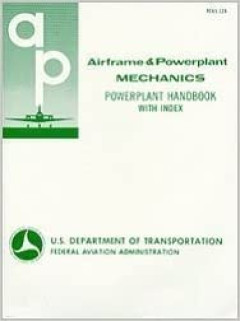
Airframe and Powerplant Mechanics Powerplant Handbook
Part 3 of a 3 part series designed to set the federal standards for A&P instruction around which all certificated coursework is based and to prepare a student for A&P certification and testing.
- Edisi
- -
- ISBN/ISSN
- 978-0891000792
- Deskripsi Fisik
- 8.5 x 1.25 x 10.75 inc. ; 519 p.
- Judul Seri
- -
- No. Panggil
- L-AMT-ApFA-I2-1>2
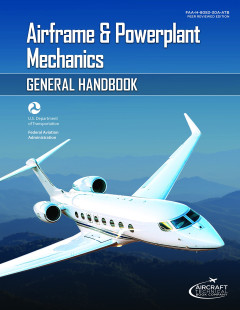
Airframe and Powerplant Mechanics General Handbook
This is the peer reviewed, corrected, and most accurate edition of FAA 8083-30a Airframe and Powerplant Mechanics General Handbook. It is the official FAA required curricula for your A&P license and the actual source from which all FAA knowledge test questions are derived. However, while FAA did a terrific job with the development of this handbook, many technical errors were overlooked. This pe…
- Edisi
- -
- ISBN/ISSN
- 978-1941144602
- Deskripsi Fisik
- 752 hlm
- Judul Seri
- -
- No. Panggil
- L-AMT-AgFA-I2-1>2
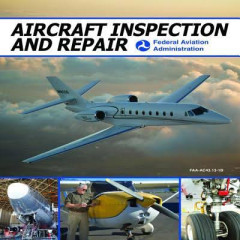
Aircraft Inspection and Repair (Acceptable Methods Techniques And Practices)
- Edisi
- -
- ISBN/ISSN
- -
- Deskripsi Fisik
- -
- Judul Seri
- -
- No. Panggil
- L-AMT-AiFA-I2-1>2
- Edisi
- -
- ISBN/ISSN
- -
- Deskripsi Fisik
- -
- Judul Seri
- -
- No. Panggil
- L-AMT-AiFA-I2-1>2

Electrical Wiring Residential-Ninth Edition
- Edisi
- -
- ISBN/ISSN
- -
- Deskripsi Fisik
- -
- Judul Seri
- -
- No. Panggil
- L-AMT-EwRm-I2-1>2
- Edisi
- -
- ISBN/ISSN
- -
- Deskripsi Fisik
- -
- Judul Seri
- -
- No. Panggil
- L-AMT-EwRm-I2-1>2
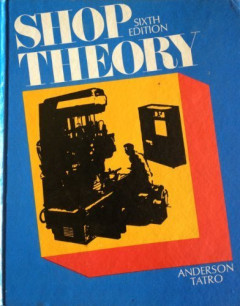
Shop Theory: 6th Edition
An introduction to safety, equipment, and procedures in the machine shop that includes coverage of career opportunities for the machinist, the principles and shop applications of the metric system of measurement, and developments in special machining processes
- Edisi
- 6
- ISBN/ISSN
- 978-0070016125
- Deskripsi Fisik
- 568 hlm : 8 x 1.25 x 9.75 inch
- Judul Seri
- -
- No. Panggil
- 621.75 JAM s

APM HB: Aircraft Structures, Assembly and Rigging, Aircraft Fabric Covering, …
- Edisi
- -
- ISBN/ISSN
- -
- Deskripsi Fisik
- -
- Judul Seri
- -
- No. Panggil
- L-AMT-APAS-I1-3>4
- Edisi
- -
- ISBN/ISSN
- -
- Deskripsi Fisik
- -
- Judul Seri
- -
- No. Panggil
- L-AMT-APAS-I1-3>4

APM HB: Hydraulics Pneumatics and Power System, Landing Gear Systems, Fire Pr…
- Edisi
- -
- ISBN/ISSN
- -
- Deskripsi Fisik
- -
- Judul Seri
- -
- No. Panggil
- L-AMT-APAS-I1-1>2
- Edisi
- -
- ISBN/ISSN
- -
- Deskripsi Fisik
- -
- Judul Seri
- -
- No. Panggil
- L-AMT-APAS-I1-1>2
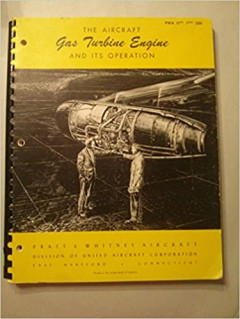
The Aircraft Gas Turbine Engine and Its Operation
- Edisi
- -
- ISBN/ISSN
- -
- Deskripsi Fisik
- ill.; 272 p.
- Judul Seri
- -
- No. Panggil
- L-AMT-Agte-I1-1>3
- Edisi
- -
- ISBN/ISSN
- -
- Deskripsi Fisik
- ill.; 272 p.
- Judul Seri
- -
- No. Panggil
- L-AMT-Agte-I1-1>3

Airplane Aerodynamics
- Edisi
- -
- ISBN/ISSN
- -
- Deskripsi Fisik
- -
- Judul Seri
- -
- No. Panggil
- L-AMT-ADST-I1-1>2
- Edisi
- -
- ISBN/ISSN
- -
- Deskripsi Fisik
- -
- Judul Seri
- -
- No. Panggil
- L-AMT-ADST-I1-1>2

NAVIGATION SYSTEM (ATA 34)
- Edisi
- -
- ISBN/ISSN
- -
- Deskripsi Fisik
- -
- Judul Seri
- -
- No. Panggil
- 629.132 51 ATR n
- Edisi
- -
- ISBN/ISSN
- -
- Deskripsi Fisik
- -
- Judul Seri
- -
- No. Panggil
- 629.132 51 ATR n

LIGHTS (ATA 33)
- Edisi
- -
- ISBN/ISSN
- -
- Deskripsi Fisik
- -
- Judul Seri
- -
- No. Panggil
- 629.136 5 ATR l
- Edisi
- -
- ISBN/ISSN
- -
- Deskripsi Fisik
- -
- Judul Seri
- -
- No. Panggil
- 629.136 5 ATR l

LANDING GEAR (ATA 32)
- Edisi
- -
- ISBN/ISSN
- -
- Deskripsi Fisik
- -
- Judul Seri
- -
- No. Panggil
- 629.134 381 ATR l
- Edisi
- -
- ISBN/ISSN
- -
- Deskripsi Fisik
- -
- Judul Seri
- -
- No. Panggil
- 629.134 381 ATR l

Helicopter Aerodynamic Outline (Bell Helicopter Trainning Center)
- Edisi
- -
- ISBN/ISSN
- -
- Deskripsi Fisik
- -
- Judul Seri
- -
- No. Panggil
- L-AMT-HeOR-I1-1>2
- Edisi
- -
- ISBN/ISSN
- -
- Deskripsi Fisik
- -
- Judul Seri
- -
- No. Panggil
- L-AMT-HeOR-I1-1>2

FUEL (ATA 28)
- Edisi
- -
- ISBN/ISSN
- -
- Deskripsi Fisik
- -
- Judul Seri
- -
- No. Panggil
- 629.134 351 ATR f
- Edisi
- -
- ISBN/ISSN
- -
- Deskripsi Fisik
- -
- Judul Seri
- -
- No. Panggil
- 629.134 351 ATR f

FLIGHT CONTROL (ATA 27)
- Edisi
- -
- ISBN/ISSN
- -
- Deskripsi Fisik
- -
- Judul Seri
- -
- No. Panggil
- 629.132 6 ATR f
- Edisi
- -
- ISBN/ISSN
- -
- Deskripsi Fisik
- -
- Judul Seri
- -
- No. Panggil
- 629.132 6 ATR f

TPE 331 Turboprop Engine Woodward Fuel Control
This item is sold for historical and reference Only. These are either ORIGINAL or COPIES of manuals and blueprints used when these aircraft were in active duty, now transferred into electronic format. This manuals and blueprints are not meant to be used for current update material for certification / repair, but make an excellent reference for the scholar, collector, modeler or aircr…
- Edisi
- -
- ISBN/ISSN
- -
- Deskripsi Fisik
- -
- Judul Seri
- -
- No. Panggil
- L-AMT-TGrt-I1-1>2
 Karya Umum
Karya Umum  Filsafat
Filsafat  Agama
Agama  Ilmu-ilmu Sosial
Ilmu-ilmu Sosial  Bahasa
Bahasa  Ilmu-ilmu Murni
Ilmu-ilmu Murni  Ilmu-ilmu Terapan
Ilmu-ilmu Terapan  Kesenian, Hiburan, dan Olahraga
Kesenian, Hiburan, dan Olahraga  Kesusastraan
Kesusastraan  Geografi dan Sejarah
Geografi dan Sejarah